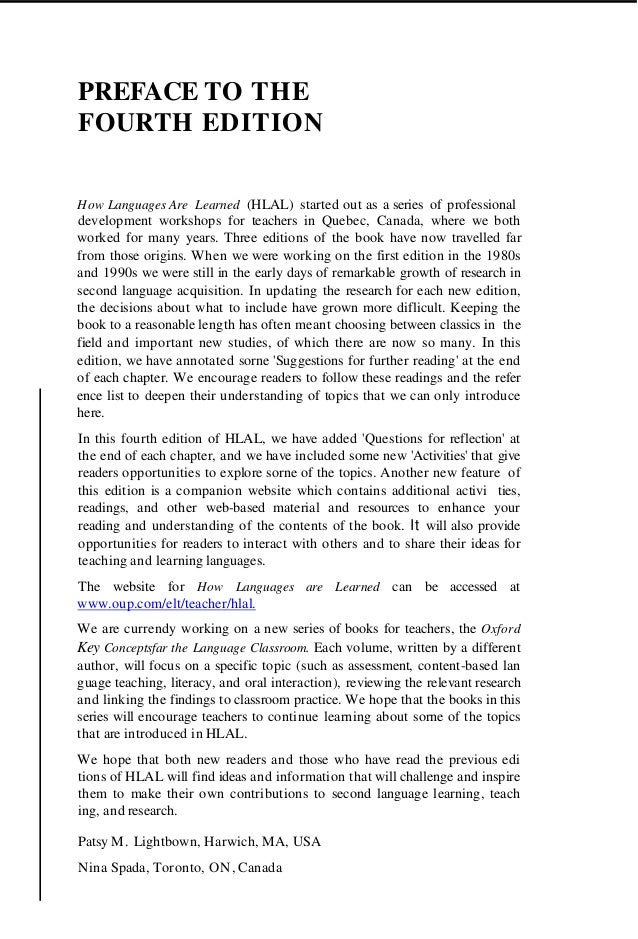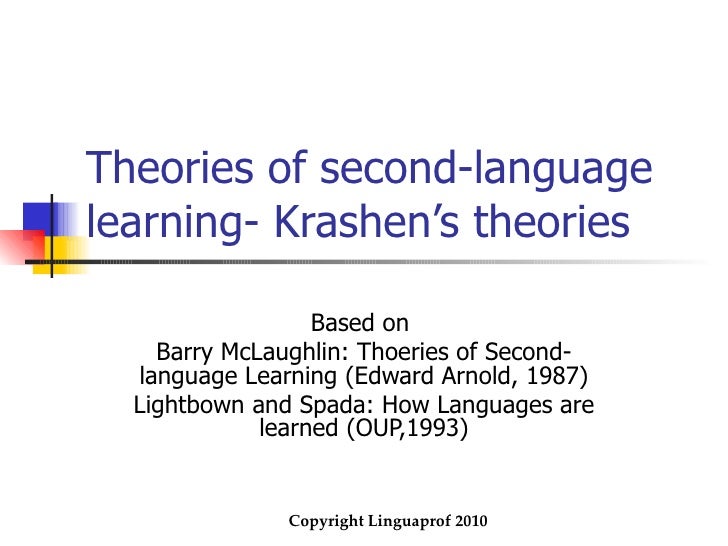Lightbown And Spada How Languages Are Learned Pdf
Resources Briefs CAL Solutions Adult ESLBriefs. Teaching Grammar to Adult English Language Learners Focus on Form. Amber Gallup Rodrguez. Center for Applied Linguistics. April 2. 00. 9 Download a PDF of this brief 1. KBBackground on Adult Learners Adult education programs serve both native English speakers and learners whose first, or native, language is not English. Native English speakers attend adult basic education ABE classes to learn basic skills needed to improve their literacy levels and adult secondary education ASE classes to earn high school equivalency certificates. Both ABE and ASE instruction help learners achieve other goals related to job, family, and further education. English language learners attend English as a second language ESL, ABE, or workforce preparation classes to improve their oral and literacy skills in English and to achieve goals similar to those of native English speakers. Audience for This Brief This brief is written for teachers, program administrators, education researchers, and policy makers to provide information on evidence based strategies for teaching grammar to adult English language learners through focus on form. Introduction. Many adult English language learners place a high value on learning grammar Ikpia, 2. Perceiving a link between grammatical accuracy and effective communication, they associate excellent grammar with opportunities for employment and promotion, the attainment of educational goals, and social acceptance by native speakers. Reflecting the disagreement that was once common in the second language acquisition research, teachers of adult English language learners vary in their views on how, to what extent, and even whether to teach grammar. Indeed, in popular communicative and task based approaches to teaching, the second language is viewed primarily as a tool for communicating rather than as an object to be analyzed Ellis, 2. Nonetheless, most research now supports some attention to grammar within a meaningful, interactive instructional context. This brief begins with a brief history of grammar instruction in the United States, including the shift from explicit to implicit approaches. It then describes the contemporary approach, called focus on form, and explores the reasons and research based evidence for drawing learners attention to language structure while they remain focused primarily on meaning. Next, it offers examples of instructional activities that can help raise learners awareness of grammar. It concludes with suggestions about areas for future research within the focus on form movement. The Evolution of Grammar Instruction. The debate over the place of grammar in instruction has played a dominant role in the history of language teaching. For much of the previous century, the debate revolved around the question of whether grammar instruction helped learners gain proficiency in a second language. The many answers to this question could be placed along a continuum with extremes at either end Gascoigne, 2. Annotated Bibliography of Works on Extensive Reading in a Second Language. Arranged in Alphabetical Order. Liu, I., Young, S. S. 2017. An exploration of. Title Issues in Promoting Multilingualism Teaching Learning Assessment Editor Prof. Prince Of Persia Two Thrones Download Free. Dr. Hanna Komorowska Reviewer Prof. Dr. Jerzy Zybert Chief Managing. Babylonia 402 www. Tema One of the advantages of modern language education is that learners errors based on transfer of mother tongue. Sepalika Malai Sinhala Song'>Sepalika Malai Sinhala Song. Issuu is a digital publishing platform that makes it simple to publish magazines, catalogs, newspapers, books, and more online. Easily share your publications and get. At one end are highly explicit approaches to grammar teaching, and at the other end lie implicit approaches that eschew mention of form. Hinkel 2. 00. 2 provides a concise history of grammar instruction in language teaching, which is summarized here. The list of historical approaches to grammar instruction is long, though certain approaches are noted for their influence. One of the earliest of these, the grammar translation approach, was characterized by rote memorization of rules and an absence of genuine communicative activities. Around the turn of the 2. Proponents of this method believed that students should learn a second language in the same way that they learned their first grammar was acquired through oral practice, drills, and repetition, not through memorization and written manipulation of explicit rules. Nevertheless, language learning was still ordered around structural principles. Audiolingualism was another structural method that shared this implicit orientation toward grammar. By the 1. 96. 0s, cognitive approaches to instruction had gained popularity. Inspired by Chomskys theory of universal grammar and the resulting emphasis on syntax, cognitive approaches represented a shift back to more explicit grammar instruction. Lightbown And Spada How Languages Are Learned Pdf' title='Lightbown And Spada How Languages Are Learned Pdf' />However, the pendulum swung again toward the implicit in the 1. These approaches emphasized meaningful interaction and authenticity in learning activities and held that communication should be the goal of instruction. Grammar was not explicitly taught proponents instead believed that accuracy would be acquired naturally over time. See Gascoigne, 2. Contemporary research on the merits of the implicit and explicit approaches described above has led to the consensus that an exclusive emphasis on either extreme impedes adult learners acquisition of English. While the inadequacies of a traditional focus on language structure alone are well documented Green Hecht, 1. Lightbown And Spada How Languages Are Learned Pdf Editor' title='Lightbown And Spada How Languages Are Learned Pdf Editor' />Lightbown And Spada How Languages Are Learned Pdf Converter
 Long, 1. Winitz, 1. Norris Ortega, 2. The noticing hypothesis is a concept in secondlanguage acquisition proposed by Richard Schmidt in 1990. He stated that learners cannot learn the grammatical features. Definitions. Second language refers to any language learned in addition to a persons first language although the concept is named secondlanguage acquisition, it. Adolescent English language learners ELLs are a growing population in secondary schools and a steady presence in postsecondary adult education programs. The Second Language Research Institute of Canada L2RIC is a leader in the field of second language education and is recognized nationally and internationally. Scott, 1. 99. 0 Skehan, 1. Indeed, experienced language teachers have long recognized the benefits of the judicious use of error correction, repetition, and even drills in the classroom Poole, 2. Gass and Selinker 2. Ellis 1. 99. 6 suggested that advanced speaking and writing proficiency, necessary for achievement of students academic and vocational goals, may require explicit form focused instruction. Moreover, studies on the practices and attitudes of teachers Borg Burns, 2. Farrell Lim, 2. Ikpia, 2. Manley Calk, 1. Paraskevas, 1. These findings and others set the stage for the current focus on form movement. Focus on Form in Instruction. Ellis 2. 00. 1 defines focus on form as any planned or incidental instructional activity that is intended to induce language learners to pay attention to linguistic form pp. This attention to form should take place within a meaningful, communicative context, making it an extension of communicative language teaching, not a departure from it. Instructors encourage learners to focus on form in several ways. Focus on form may be planned and focused on pre selected structures, or it may be incidental, arising spontaneously at any point in a communicative activity. Teachers might design a task to encourage learners to notice forms in the input e. Focus on form may be reactive, including explicit corrections to student language recasts saying what students have said, but differently clarification requests and other types of feedback. Focus on form is most frequently teacher initiated, but it is also initiated by learners through questions and requests for explanation Poole, 2. Although second language acquisition research has not definitively answered many important questions regarding form focused instruction, studies have provided promising evidence that focus on form is correlated with more acquisition of new grammar and vocabulary than non form focused approaches. Ellis, Basturkmen, and Loewen 2. Loewen 2. 00. 2 found that short episodes of corrective feedback correlated with higher rates of correctness on subsequent tests. Some empirical studies have found that various focus on form techniques discussed below have led to more accurate use of target structures Camhi Ebsworth, 2. Doughty Verela, 1. Jourdenais, Ota, Stauffer, Boyson, Doughty, 1.
Long, 1. Winitz, 1. Norris Ortega, 2. The noticing hypothesis is a concept in secondlanguage acquisition proposed by Richard Schmidt in 1990. He stated that learners cannot learn the grammatical features. Definitions. Second language refers to any language learned in addition to a persons first language although the concept is named secondlanguage acquisition, it. Adolescent English language learners ELLs are a growing population in secondary schools and a steady presence in postsecondary adult education programs. The Second Language Research Institute of Canada L2RIC is a leader in the field of second language education and is recognized nationally and internationally. Scott, 1. 99. 0 Skehan, 1. Indeed, experienced language teachers have long recognized the benefits of the judicious use of error correction, repetition, and even drills in the classroom Poole, 2. Gass and Selinker 2. Ellis 1. 99. 6 suggested that advanced speaking and writing proficiency, necessary for achievement of students academic and vocational goals, may require explicit form focused instruction. Moreover, studies on the practices and attitudes of teachers Borg Burns, 2. Farrell Lim, 2. Ikpia, 2. Manley Calk, 1. Paraskevas, 1. These findings and others set the stage for the current focus on form movement. Focus on Form in Instruction. Ellis 2. 00. 1 defines focus on form as any planned or incidental instructional activity that is intended to induce language learners to pay attention to linguistic form pp. This attention to form should take place within a meaningful, communicative context, making it an extension of communicative language teaching, not a departure from it. Instructors encourage learners to focus on form in several ways. Focus on form may be planned and focused on pre selected structures, or it may be incidental, arising spontaneously at any point in a communicative activity. Teachers might design a task to encourage learners to notice forms in the input e. Focus on form may be reactive, including explicit corrections to student language recasts saying what students have said, but differently clarification requests and other types of feedback. Focus on form is most frequently teacher initiated, but it is also initiated by learners through questions and requests for explanation Poole, 2. Although second language acquisition research has not definitively answered many important questions regarding form focused instruction, studies have provided promising evidence that focus on form is correlated with more acquisition of new grammar and vocabulary than non form focused approaches. Ellis, Basturkmen, and Loewen 2. Loewen 2. 00. 2 found that short episodes of corrective feedback correlated with higher rates of correctness on subsequent tests. Some empirical studies have found that various focus on form techniques discussed below have led to more accurate use of target structures Camhi Ebsworth, 2. Doughty Verela, 1. Jourdenais, Ota, Stauffer, Boyson, Doughty, 1.